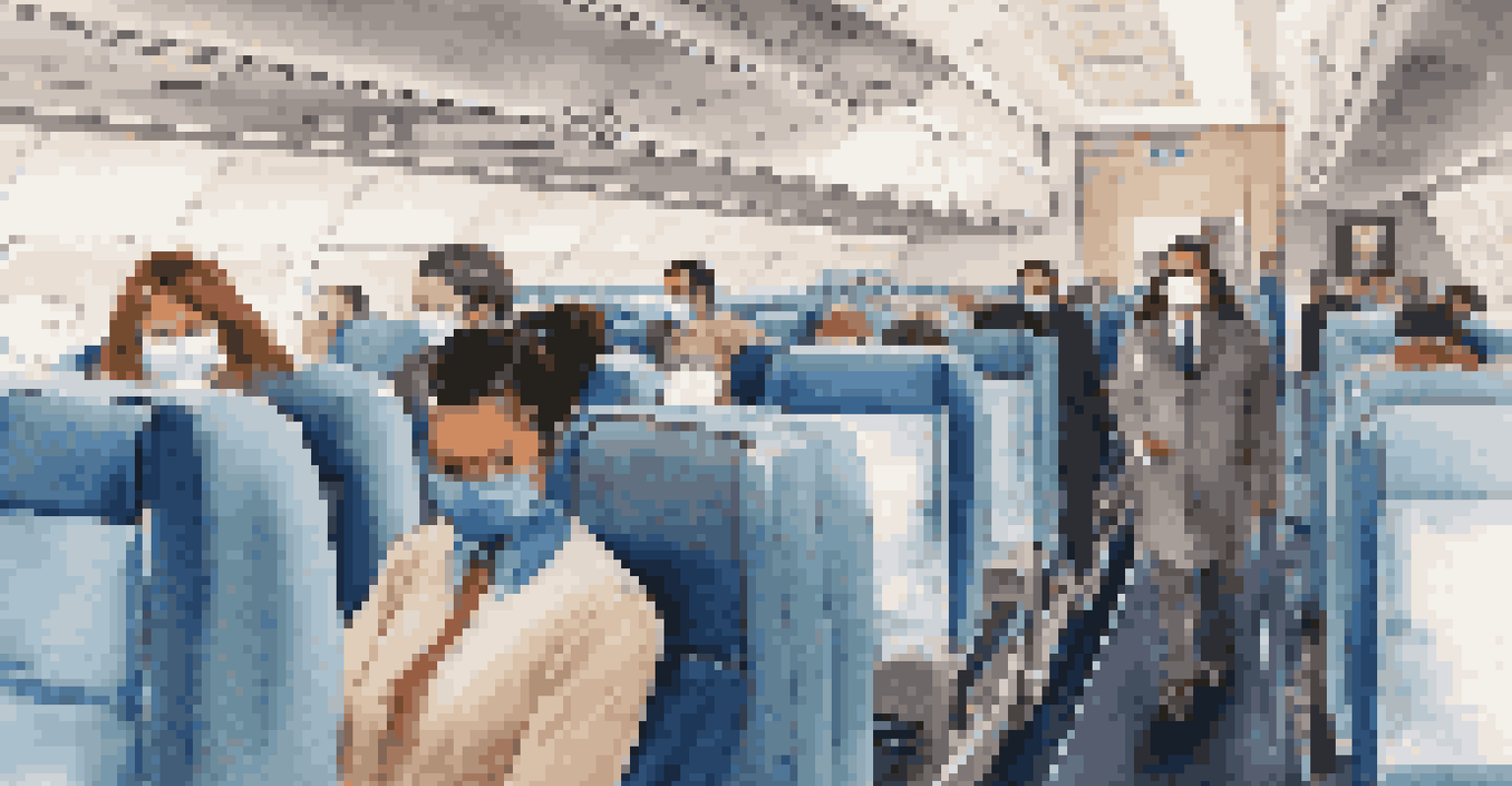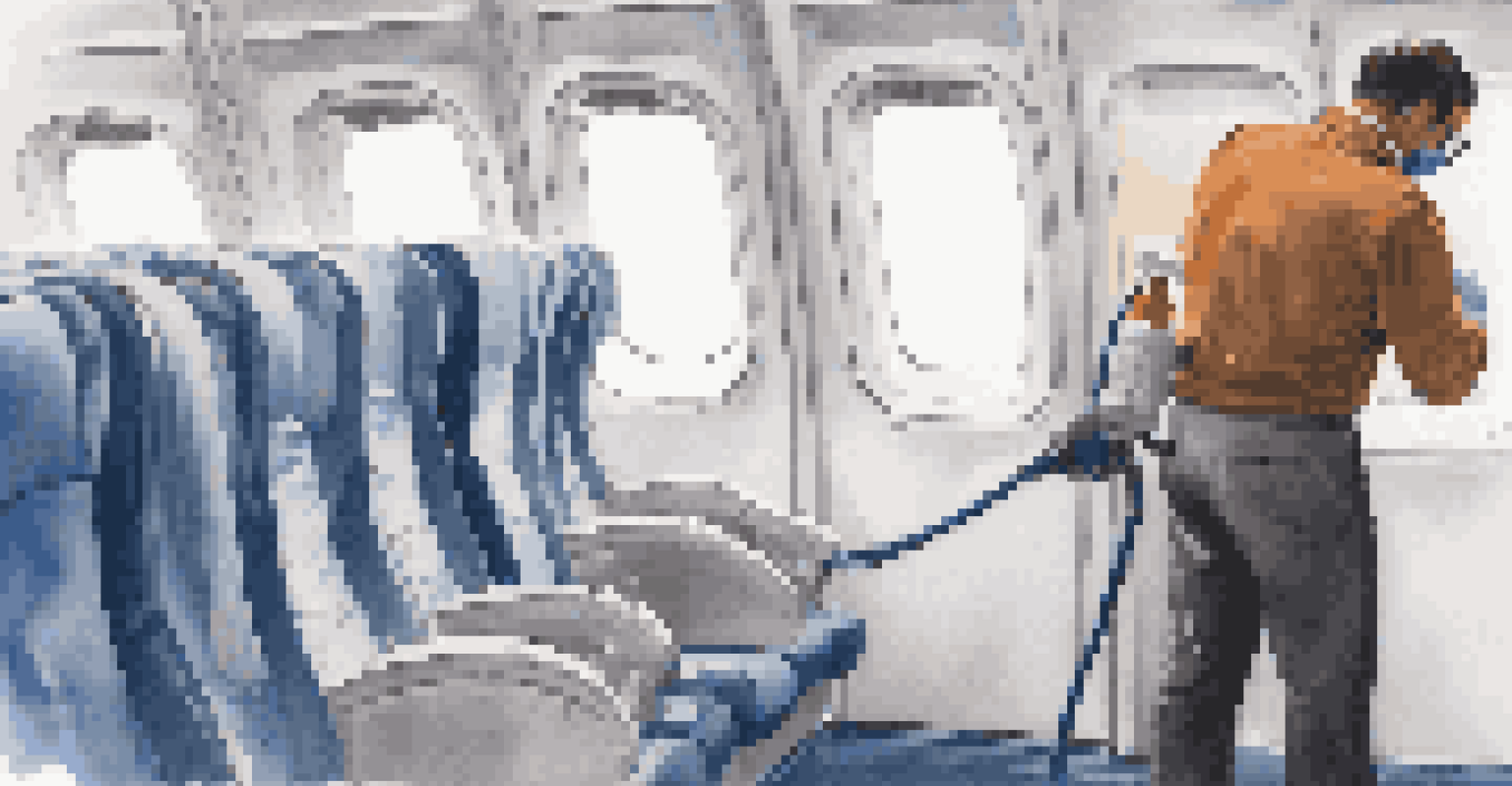Air Travel Safety During Pandemics: What to Expect

Understanding Air Travel Safety Measures in a Pandemic
In recent years, air travel has been significantly impacted by pandemics, leading to increased safety measures. Airlines and airports are now implementing enhanced cleaning protocols, social distancing guidelines, and health screenings to ensure passengers feel secure. This evolution in air travel safety reflects a commitment to protecting public health while maintaining the convenience of flying.
Air travel is the safest form of transportation, but we must all do our part to ensure it remains that way.
For example, many airlines have adopted the use of electrostatic sprayers to disinfect cabin surfaces, which helps eliminate germs effectively. Passengers can also expect to see more signage promoting hygiene practices, such as frequent hand washing and mask-wearing. These measures not only help ensure passenger safety but also build confidence in the air travel experience.
As travel restrictions and guidelines vary by location, it’s essential for travelers to stay informed about the specific safety measures in place at their departure and arrival airports. By understanding these protocols, passengers can better prepare for their journey and contribute to a safer travel environment.
The Role of Masks and Personal Protective Equipment
Masks have become a familiar part of air travel during pandemics, serving as a critical line of defense against virus transmission. Airlines typically require passengers to wear masks throughout the flight, and many provide complimentary face coverings if needed. This simple action not only protects the wearer but also those around them, creating a safer cabin environment.

In addition to masks, some travelers may choose to wear gloves or face shields for added protection. While gloves can provide a sense of security, it's essential to remember that proper hand hygiene is still crucial. Regularly sanitizing hands, especially after touching shared surfaces, can significantly reduce the risk of infection.
Enhanced Safety Measures for Air Travel
Airlines and airports are implementing rigorous cleaning protocols, health screenings, and mask requirements to ensure passenger safety during pandemics.
Overall, wearing masks and other personal protective equipment is a small effort that contributes to the collective safety of all passengers and crew members. As travelers become accustomed to these practices, they’ll help normalize this new standard in the aviation industry.
Health Screenings and Pre-Travel Testing Requirements
Before embarking on a flight, travelers may encounter health screenings and pre-travel testing requirements, especially during pandemics. These measures aim to identify potential COVID-19 cases before boarding, reducing the chances of outbreaks on flights. Airports may conduct temperature checks or require proof of a negative test result taken within a specified timeframe.
The safety of our passengers and crew is our top priority, and we are committed to implementing the necessary measures to protect everyone during these challenging times.
For instance, some airlines have implemented digital health passes that allow passengers to upload their test results and vaccination status for verification. This streamlined process can ease the travel experience while ensuring compliance with health regulations. However, travelers should always check with their airline and destination for the latest requirements.
Being prepared for these health screenings not only expedites the boarding process but also reinforces a culture of safety within the travel community. By cooperating with these protocols, passengers contribute to a collective effort to keep everyone safe during their journey.
Enhanced Cleaning Protocols on Flights and in Airports
Airlines and airports have ramped up their cleaning protocols to address health and safety concerns during pandemics. High-touch areas, such as armrests, tray tables, and restrooms, are receiving more frequent and thorough sanitation. This diligent attention to cleanliness helps reassure passengers that their health is a top priority.
Many airlines are also using advanced cleaning technologies, such as UV-C light disinfection systems, to eliminate germs from aircraft surfaces. These innovations not only enhance the safety of the flying experience but also demonstrate the industry’s commitment to adapting in response to health crises.
Importance of Air Quality on Flights
Modern aircraft are equipped with advanced ventilation systems that significantly reduce airborne viruses, creating a safer flying environment.
As travelers board their flights, they can take comfort in knowing that robust cleaning measures are in place. This collaborative approach between airlines and passengers fosters a safer travel atmosphere and encourages confidence in the air travel experience.
Social Distancing Practices at Airports and on Planes
Social distancing has become a key component of air travel safety during pandemics, helping to minimize close contact between passengers. Airports are implementing measures such as spaced seating in waiting areas and signage to encourage travelers to maintain distance while in lines. These adjustments aim to create a more comfortable environment for travelers who may be anxious about flying.
In addition to airport measures, airlines are also adopting social distancing practices during boarding and deplaning. For example, some airlines now board passengers in smaller groups to reduce crowding at the gate. This thoughtful approach helps alleviate stress during the boarding process and promotes a sense of order.
By prioritizing social distancing, the aviation industry demonstrates its dedication to passenger safety. As travelers embrace these new norms, they contribute to a collective effort to ensure a safer flying experience for everyone.
Air Quality and Ventilation Systems on Aircraft
Air quality is another critical factor in ensuring safety during air travel amid a pandemic. Modern aircraft are equipped with advanced ventilation systems that filter cabin air, removing up to 99.9% of airborne viruses and bacteria. This technology helps create a safer environment for passengers and crew during flights.
Additionally, many airlines are increasing the frequency of air exchanges within the cabin, often exchanging the air every 2-3 minutes. This constant refreshment of air makes flying safer, as it reduces the likelihood of virus transmission. Passengers can rest assured that they are breathing clean air during their journey.
Post-Travel Vigilance is Key
Travelers should continue to follow health guidelines and monitor their health after arriving at their destination to minimize the risk of spreading illness.
Understanding the science behind aircraft ventilation can help alleviate concerns about airborne diseases while flying. With these advanced systems in place, travelers can focus on enjoying their journey rather than worrying about air quality.
Post-Travel Safety Recommendations for Travelers
After arriving at their destination, travelers should continue to prioritize safety by following local health guidelines. This may include wearing masks, practicing social distancing, and adhering to any quarantine requirements. By doing so, they not only protect themselves but also reduce the risk of spreading illness to others.
Travelers should also consider monitoring their health for any symptoms related to respiratory illnesses in the days following their journey. If symptoms arise, it's essential to seek medical advice and get tested to ensure the safety of themselves and those around them. Staying vigilant post-travel is just as crucial as the precautions taken during the flight.

By adopting a proactive approach to health and safety, travelers can enjoy their adventures while minimizing risks. These habits create a culture of responsibility and care within the travel community, fostering a safer environment for everyone.